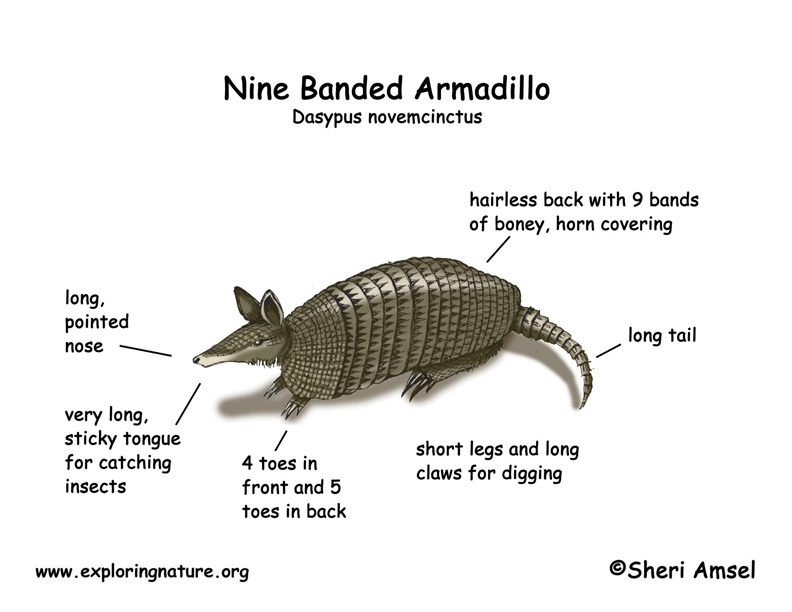

They are found in the south central and southeastern U. S., south to Peru and Uruguay and on the islands of Granada, Trinidad and Tobado.
They live in thick bushy areas.
They are a yellowish-brown color with almost no hair on their thick back, made of bands of horn and bone. There is some hair on their bellies. They can be up to 3.5 feet long including their tail. They have a long, pointed nose, and a very long, sticky tongue for catching insects. They have short legs and long claws for digging.
They are active mostly at night (nocturnal). They dig burrow to sleep and hide in. They grunt when they are looking for food. When they are frightened they go into a burrow or thick brush or curl up the best they can (they cannot curl into a ball like other kinds of armadillos). They can swim.
They eat insects — mostly beetles and ants, spiders and amphibians (frogs, toads and salamanders), but will eat fruits and plants.
They can be eaten by jaguar, puma and coyote.
Females are pregnant (gestation) for 4 months. In a large nest of grass and leaves, she has 4 babies that are exactly alike (they are from the same egg so are identical).
They live 12-15 years in the wild. They are not a threatened species.
Kingdom: Animalia
Phylum: Chordata
Subphylum: Vertebrata
Class: Mammalia
Order: Cingulata
Family: Dasypodidae
Subfamily: Dasypodinae
Genus: Dasypus
Species: Dasypus novemcinctus
When you research information you must cite the reference. Citing for websites is different from citing from books, magazines and periodicals. The style of citing shown here is from the MLA Style Citations (Modern Language Association).
When citing a WEBSITE the general format is as follows.
Author Last Name, First Name(s). "Title: Subtitle of Part of Web Page, if appropriate." Title: Subtitle: Section of Page if appropriate. Sponsoring/Publishing Agency, If Given. Additional significant descriptive information. Date of Electronic Publication or other Date, such as Last Updated. Day Month Year of access < URL >.
Amsel, Sheri. "Armadillo (Nine Banded)" Exploring Nature Educational Resource ©2005-2024. December 13, 2024
< http://www.exploringnature.org/db/view/Armadillo-Nine-Banded >

